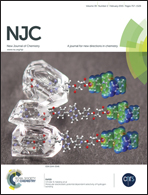Development of a poly(ethylene glycol)–graphene oxide sol–gel coating for solid-phase microextraction of aromatic amines in water samples with a gas chromatography-flame ionization detector method
Abstract
This study proposes a simple method for the preparation of a graphene oxide (GO) nano-sheet modified solid-phase microextraction (SPME) fiber via a sol–gel technique. For the first time, the prepared polyethylene glycol–graphene oxide (PEG–GO) sol–gel coating was applied for the analysis of aromatic amines in aqueous samples as target compounds. Important parameters that influence the extraction efficiency, such as desorption temperature and time, extraction temperature, extraction time, stirring speed, salting effect and pH, were investigated and optimized in detail. Under optimized condition, the linearity for the analytes was in the concentration range of 0.001 to 200 ng mL−1. Limits of detection (S/N = 3) of between 0.0003 to 0.2 ng mL−1 were obtained. The relative standard deviation (RSD) values for one fiber (repeatability) (n = 5) ranged from 4.2 to 6.6% and reproducibility between fibers (n = 3) was found to be below 8%. The developed method was successfully applied to real water samples, while relative recoveries obtained for spiked water samples ranged from 92.6 to 107.4%.


 Please wait while we load your content...
Please wait while we load your content...